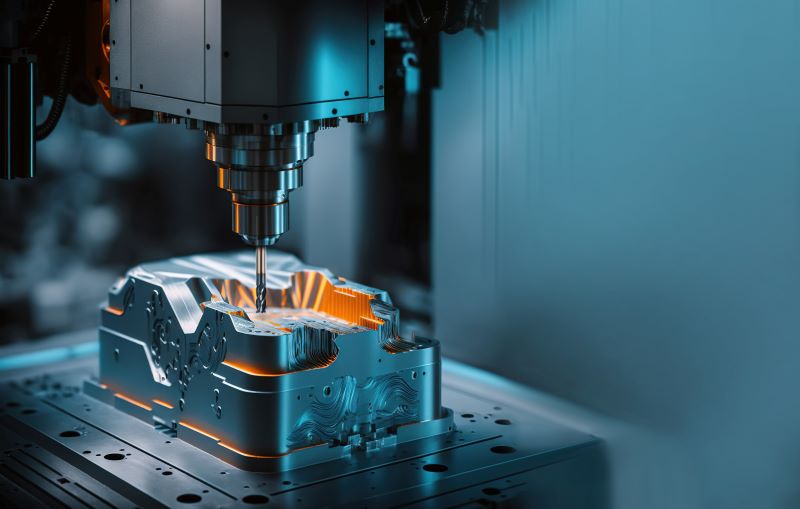In the field of construction, precision, efficiency, and safety are critical. Traditionally, achieving these has often required significant manual labor and time. But what if there were a more efficient approach that could revolutionize the industry?
Computer Numerical Control (CNC) machining is an innovative technology that has the potential to transform traditional construction practices. By providing a high level of accuracy and speed, CNC machining can improve the efficiency of construction processes. But how does it accomplish this, and what does it mean for the future of the industry?
In this article, we’ll explore CNC machining’s significant role in the construction sector. We’ll unpack its impact and investigate its potential to further transform the industry.
What Is CNC Machining?
CNC machining is a manufacturing process that utilizes computer-controlled devices to perform complex tasks with precision. The process follows instructions from a software file, typically a Computer-Aided Design (CAD) file, to manipulate construction materials in specific ways.
In the construction industry, several types of CNC machines are commonly employed:
- CNC Milling Machines: These devices utilize rotating tools to remove material from a workpiece. In construction, they’re often used for creating custom components or intricate architectural details.
- CNC Lathes: Lathes spin the workpiece and use cutting tools to shape it. They’re ideal for creating cylindrical components like pipes or pillars.
- CNC Routers: Especially useful in the construction industry, a CNC router can precisely cut materials like wood, plastics, and metals. They’re often used for creating decorative elements, signage, and even some structural components.
By gaining a deeper understanding of CNC machining, we can appreciate its significant benefits to the construction industry, which we’ll explore next.

The Benefits Of CNC Machining In Construction
CNC machining’s incorporation into the construction industry has led to several advantages, including the following:
- High Precision: CNC machines follow digital blueprints to the letter, ensuring each cut, drill, or mold aligns perfectly with the design. This accuracy helps avoid costly mistakes and yields higher-quality results.
- Enhanced Efficiency: CNC machines can operate continuously, without fatigue or the need for breaks, speeding up production timelines. The automation also allows workers to focus on higher-level tasks, improving overall workflow.
- Versatility In Material Handling: CNC machines can work with a wide range of materials—from wood to steel—broadening the scope of possible construction projects. Moreover, they can handle these materials with the same level of precision and efficiency.
- Waste Reduction: With their precision, CNC machines significantly reduce material waste. This not only cuts costs but also makes construction processes more environmentally friendly.
By providing these benefits, CNC machining is significantly altering the way we approach construction. Up next, let’s take a look at some real-world applications of this technology.
CNC Machining: Practical Examples
CNC machining’s potential is already becoming evident through several notable applications in the construction industry.
- Concrete 3D Printing: Using a CNC machine specially designed to extrude (shape or form) concrete, companies have begun to 3D print entire structures. These machines follow digital blueprints to create complex structures with precision and efficiency, drastically reducing construction time.
- Automated Bricklaying: Robots, such as the Semi-Automated Mason or SAM100, use CNC technology to lay bricks with incredible speed and accuracy, completing tasks that would have taken a team of workers several days in just a few hours.
- Production Of Intricate Architectural Designs: CNC routers and milling machines enable the creation of complex, precision-crafted components for buildings. This capability opens up new architectural possibilities, allowing for the design of more innovative and intricate structures.
These case studies illustrate the tangible impact of CNC machining today. But what could it mean for the industry’s future?
The Future In Construction
As we look ahead, the role of CNC machining in construction seems poised to expand even further. Here are a few anticipated developments:
- Integration With Emerging Technologies: As technologies like artificial intelligence (AI) and virtual reality (VR) mature, we can expect them to integrate with CNC systems. This could allow for even more precision and efficiency, and open new possibilities for remote operation and automation.
- Widespread Adoption: As the benefits of CNC machining become increasingly apparent, more construction firms will likely invest in this technology. This would not only enhance the quality and efficiency of construction projects, but also make them more cost-effective and sustainable.
- More Sustainable Practices: By reducing waste and enabling the use of eco-friendly materials, CNC machining has the potential to make construction more sustainable. This is an increasingly important factor as the industry seeks to reduce its environmental impact.
CNC machining is making a big difference in the construction industry. The examples we’ve highlighted demonstrate current applications, but they merely scratch the surface of what’s possible as this technology continues to evolve. Indeed, the future of construction looks set to be shaped by CNC machining in ways that are yet to be fully realized.
Final Thoughts
The influence of CNC machining on the construction industry is significant and undeniable. Its impact is evident in the accuracy, efficiency, and flexibility it brings to construction processes, and the practical applications we’ve explored.
Looking to the future, the further integration of CNC machining and similar advancements will continue to shape the construction industry. We anticipate this digital shift will result in even more precise, cost-effective, and sustainable building practices. The promise of CNC machining in construction is clear—a future with smarter, faster, and greener projects.

